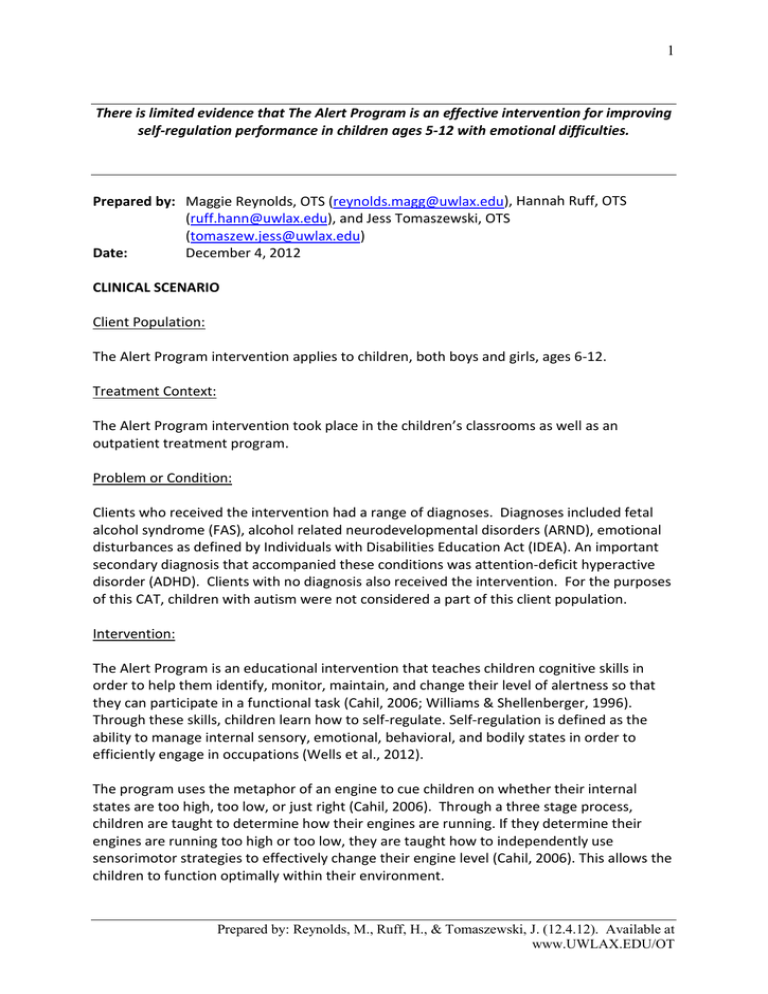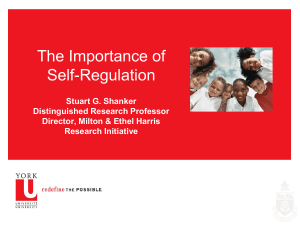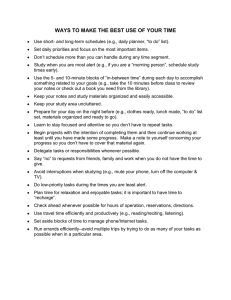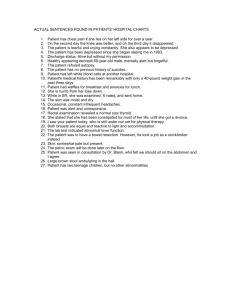1 There is limited evidence that The Alert Program is an... self-regulation performance in children ages 5-12 with emotional difficulties.
advertisement

1 There is limited evidence that The Alert Program is an effective intervention for improving self-regulation performance in children ages 5-12 with emotional difficulties. Prepared by: Maggie Reynolds, OTS (reynolds.magg@uwlax.edu), Hannah Ruff, OTS (ruff.hann@uwlax.edu), and Jess Tomaszewski, OTS (tomaszew.jess@uwlax.edu) Date: December 4, 2012 CLINICAL SCENARIO Client Population: The Alert Program intervention applies to children, both boys and girls, ages 6-12. Treatment Context: The Alert Program intervention took place in the children’s classrooms as well as an outpatient treatment program. Problem or Condition: Clients who received the intervention had a range of diagnoses. Diagnoses included fetal alcohol syndrome (FAS), alcohol related neurodevelopmental disorders (ARND), emotional disturbances as defined by Individuals with Disabilities Education Act (IDEA). An important secondary diagnosis that accompanied these conditions was attention-deficit hyperactive disorder (ADHD). Clients with no diagnosis also received the intervention. For the purposes of this CAT, children with autism were not considered a part of this client population. Intervention: The Alert Program is an educational intervention that teaches children cognitive skills in order to help them identify, monitor, maintain, and change their level of alertness so that they can participate in a functional task (Cahil, 2006; Williams & Shellenberger, 1996). Through these skills, children learn how to self-regulate. Self-regulation is defined as the ability to manage internal sensory, emotional, behavioral, and bodily states in order to efficiently engage in occupations (Wells et al., 2012). The program uses the metaphor of an engine to cue children on whether their internal states are too high, too low, or just right (Cahil, 2006). Through a three stage process, children are taught to determine how their engines are running. If they determine their engines are running too high or too low, they are taught how to independently use sensorimotor strategies to effectively change their engine level (Cahil, 2006). This allows the children to function optimally within their environment. Prepared by: Reynolds, M., Ruff, H., & Tomaszewski, J. (12.4.12). Available at www.UWLAX.EDU/OT 2 The first stage of the program helps the child become aware that everyone has different arousal states (Williams & Shellenberger, 1996). This stage focuses on the cognitive aspect of the intervention (Williams & Shellenberger, 1996). The child is taught that it is important to be aware of arousal states in order to function appropriately within their various environments (Williams & Shellenberger, 1996). Stage two introduces the child to sensorimotor methods that influence his or her level of arousal (Williams & Shellenberger, 1996). During this stage, the child and the therapist collaborate to determine the most effective strategies for either increasing or decreasing his or her level of arousal (Williams & Shellenberger, 1996). In stage three, the child and the therapist work together to practice identifying arousal levels and implementing appropriate sensorimotor strategies (Barnes, Schoenfeld, Garza, Johnson & Tobias, 2005). The Alert Program manual does not state a specific protocol for the time of each session, number of sessions, or how the session is formatted. Rather, the manual states that treatment time should be based off the needs of each individual child (Williams & Shellenberger, 1996). Science Behind Intervention: This is an educational intervention that teaches children cognitive skills, specifically metacognition and executive functioning, in order to better self-regulate sensory arousal. Metacognition refers to an individual conscious awareness and understanding of his or her cognitive processes (Flavell, 1979). For the purpose of this CAT review, metacognition and executive functioning are not differentiated. When children are first learning a new skill, there are two factors to consider. First, information is acquired automatically, and then over time this information comes under active conscious control (Vygotsky, 1962). Metacognition develops naturally in children between the ages of four and nine. However, if metacognition does not develop in a timely manner there are strategies educators can use to facilitate its development. In order to teach children how to learn at a conscious level, educators or therapists need to help children become more aware of their thought processes (Flavell, 1995). Teaching metacognition involves educators explicitly stating their thinking processes aloud, and using empathetic challenging. This brings the thinking processes to the conscious level and helps children better understand their thinking (Fisher, 1998). Once a child identifies his or her level of arousal, they then select and implement an appropriate sensorimotor strategy to obtain an optimal level of alertness. Alertness is defined as a state of the nervous system (Williams & Shellenberger, 1996). In order to be alert, sensory information (oral motor, proprioception, tactile, visual, auditory, and vestibular) is relayed from sensory receptors to the reticular formation, to the cortex in order to “wake up” the brain (Williams & Shellenberger, 1996). By changing the information being sent through the various sensory systems, it is believed that a change in arousal can be initiated, and the body can be at a more optimal level of alertness. It is necessary for the nervous system to be in an optimal state of arousal to function in a particular task (Schaaf & Lane, 2009). Prepared by: Reynolds, M., Ruff, H., & Tomaszewski, J. (12.4.12). Available at www.UWLAX.EDU/OT 3 Why is this intervention appropriate for Occupational Therapy?: A child’s main occupations are play, education, and social participation (AOTA, 2008). In order to have optimal occupational performance in these activities, children need to have an appropriate level of arousal. Occupational therapists can help children self-regulate by teaching them how to recognize and implement strategies to either increase or decrease their level of arousal, so that it is at the optimal level for full participation in occupations. The Alert Program intervention addresses educational participation (AOTA, 2008). The specific performance skills this intervention addresses are emotional regulation skills and cognitive skills. Within cognitive skills, this intervention specifically addresses executive functioning and metacognition (AOTA, 2008). This intervention is a prepatory method as it prepares the child for occupational performance by getting the brain at the appropriate level of arousal in order to engage in occupations (AOTA, 2008). FOCUSED CLINICAL QUESTION: Is The Alert Program an effective intervention for improving self-regulation in children ages 6-12 with emotional difficulties when compared to no treatment? SUMMARY: The clinical question for this CAT is: Is The Alert Program an effective intervention for improving self-regulation in children ages 6-12 with emotional difficulties when compared to no treatment? There were a total of four data bases searched with a total of six relevant articles located. Of these six articles only three articles met the level of rigor required for this CAT review. Of these articles, one was a randomized controlled trial, one was a quasiexperimental study, and one was a case-study. The overall strength of the articles is 2a meaning that there is limited evidence. The studies selected were the only articles available that were not expert opinion. There is limited evidence that The Alert Program is an effective intervention for improving self-regulation performance in children ages 6-12 with emotional difficulties. CLINICAL BOTTOM LINE: There is limited evidence that The Alert Program is an effective intervention for improving self-regulation performance in children ages 6-12 with emotional difficulties. Limitation of this CAT: This critically appraised topic has been reviewed by occupational therapy graduate students and the course instructor. SEARCH STRATEGY: Prepared by: Reynolds, M., Ruff, H., & Tomaszewski, J. (12.4.12). Available at www.UWLAX.EDU/OT 4 Table 1: Search Strategy Databases Searched • Education → Ebscohost • OT Search • Ebscohost • PubMed Search Terms • • • • Limits used Alert Program Engine Program Self-Regulation Strategies School-based • English 2002 2012 Inclusion and Exclusion Criteria • Exclusion: Autism RESULTS OF SEARCH Table 2: Summary of Study Designs of Articles Retrieved Level Study Design/ Methodology of Articles Retrieved Total Number Data Base Located Source Citation (Name, Year) Level 1a Systematic Reviews or Metanalysis of Randomized Control Trials Level 1b Individualized Randomized Control Trials 1 (Wells, 2012) Level 2a Systematic reviews of cohort studies Level 2b Individualized cohort studies and low quality RCT’s (PEDRO < 6)3 Level 3a Systematic review of case-control studies Level 3b Case-control studies and nonrandomized controlled trials 1 (Barnes, 2008) Level 4 Case-series and poor quality cohort and case-control studies 1 (Cahill, 2006) Level 5 Expert Opinion 3 (Barnes, 2005) (Maas, 2003) (Salls & Bucey, 2003) Prepared by: Reynolds, M., Ruff, H., & Tomaszewski, J. (12.4.12). Available at www.UWLAX.EDU/OT 5 STUDIES INCLUDED Table 3: Summary of Included Studies Study 1 Wells (2012) Study 2 Barnes (2008) Study 3 Cahill (2006) Design and Randomized PEDRO rating Controlled Trial PEDRO rating: 5 Quasi-experimental pretest-posttest design Case Study Population -12 Children ages 9-11 -four classrooms for children with emotional disturbance in public school -n = 7 intervention -n = 5 control 31 Children in first grade, no ages or diagnoses stated Intervention Neurocognitive Investigated Habilitation Therapy: which included an adapted version of The Alert Program -75 min. x 1x/wk x 12 wks. -Caregivers received educational sessions during this time. - Treatment was administered by doctoral and masters level therapists, and an OT with experience with child-interventions. The Alert Program · 8 weeks of intervention · 3 sessions per week for 3 weeks · Decrease by 1 session every 2 weeks -The Alert Program steps and procedures followed as per The Alert Program manual The Alert Program: -20 minute groups x 1x/week (doesn’t state for how many weeks) run by OT and general education teacher - 3 Stages Comparison -No Intervention Intervention Control -Compared in retrospect to · A researcher spent the prior “Bad Apples” class same amount of time in management system. the control classroom as in the intervention group. · No training was provided -Participants recruited from Illinois Department of Children and Family Services (DCFS) general child welfare and children living in adopted homes -6 yr. - 11 yr. 11mo. - All children had FAS or ARND -n=40 intervention -n=38 control Prepared by: Reynolds, M., Ruff, H., & Tomaszewski, J. (12.4.12). Available at www.UWLAX.EDU/OT 6 to the students in the control group. Dependent Variables -Executive Functioning, specifically emotional control Outcome Measures - Behavior Rating ·Self – Efficacy for self Inventory of regulation questionairre Executive Function (BRIEF) – breaks executive functioning into 8 different factors. Results - No statistically significant improvements on emotional control were found within the treatment group – When all 8 factors of executive functioning were examined together, treatment group improved statistically significantly more than control group. -In the treatment group, N/A teachers ratings of student’s self-efficacy for self-regulation increased from pre to post test for all but 2 students. - All teacher ratings of student’s self-efficacy for self-regulation in the control group decreased from pre to post test. Effect Size Main Effect: .30 This is a medium effect size. N/A Conclusion Findings from this These results showed study provide children who received The evidence that the Alert Program showed neurocognitive small improvements from habilitation pretest to posttest on curriculum, which teacher self-efficacy included an adapted ratings. Children in the of The Alert Program, control group showed no is an effective improvements or regressed. However, this intervention to improve executive -Self efficacy of selfregulation No dependent variable No specific outcome measure used - teacher satisfaction and continued implementation of program was recorded N/A After training and implementation of The Alert Program with the students and teacher, the teacher found it to be a useful classroom management system for her first grade class. Prepared by: Reynolds, M., Ruff, H., & Tomaszewski, J. (12.4.12). Available at www.UWLAX.EDU/OT 7 functioning deficits study was limited by the in children with FAS small sample size. or ARND. IMPLICATIONS FOR PRACTICE, EDUCATION and FUTURE RESEARCH Overall Conclusions: Three articles were reviewed in this CAT. Of these three articles, one was a randomized controlled trial (Wells, Chasnoff, Schmidt, Telford, & Schwartz, 2012), one was a quasiexperimental study (Barnes, Vogel, Beck, Schoenfeld, & Owen, 2008), and the last was a case study (Cahill, 2006). All articles examined self-regulation to some degree. Selfregulation is defined as the child’s management of internal sensory, emotional, behavioral, and bodily states in order to efficiently engage in occupations (Wells et al., 2012). The Alert Program intervention focuses on using executive functioning in order for the child to recognize the need to change their arousal. This allows them to function optimally. Part of executive functioning is the ability to have emotional control. For this CAT, emotional control is considered part of self-regulation. Wells et al. (2012) found no statistically significant difference on emotional control between treatment and control groups. In addition to emotional control, the study by Wells et al. (2012) examined seven other executive functioning skills. The two subtests that improved significantly at post-test between the groups were organization and monitor (Wells et al., 2012). In addition, when all eight executive functioning skills were considered as a whole, the treatment group improved statistically significantly more than the control group on executive functioning performance (Wells et al., 2012). This is important as Wells et al. (2012) has suggested an association between executive functioning and emotional selfregulation performance. The authors believed that by targeting executing functioning, they could promote improved self-regulation performance. Further research is needed to validate this suggested association. Similar results were found by Barnes, Vogel, Beck, Schoenfeld, & Owen (2008) when measured by teacher perceptions of students’ self regulation performance. Overall, the teachers thought that the children that received The Alert Program improved compared to the children that were not (Barnes et al., 2008). These results were consistent with results from the study by Cahill (2006) indicating that implementation of The Alert Program resulted in increased satisfaction by the teacher as an efficient self-regulation strategy for her students. The three studies examined yielded consistent results regarding the effectiveness of The Alert Program. All studies showed that children improved on selected outcome measures despite differences in populations, how the program was implemented, and total treatment Prepared by: Reynolds, M., Ruff, H., & Tomaszewski, J. (12.4.12). Available at www.UWLAX.EDU/OT 8 time. The population that was included in the Wells et al. (2012) study included children that had a diagnosis of either fetal alcohol syndrome (FAS) or alcohol related developmental disorders (ARND). These children ranged in age from 6 to 11 years, 11 months old. The population in the study by Barnes et al. (2008) included children with emotional disturbances, as defined by IDEA, ranging in age from nine to eleven. The last study’s population was a first grade class with no diagnosis or age range provided (Cahill, 2006). Wells et al. (2012) implemented an adaptation of The Alert Program, which consisted of caregiver education. Exact treatment time for all studies was not reported. However, treatment times ranged from eight to twelve weeks, with 20 to 75 minute treatment sessions, occurring one to three times per week. In conclusion, this CAT provides limited evidence (2a) as to the effectiveness of The Alert Program in improving self-regulation in children ages 6-12 with emotional difficulties. Boundaries: Between the three studies there were a total of 121 participants ranging in age from 6 to 11 years, 11 months. One important exclusion criteria was a diagnosis of autism. In the study by Wells et al. (2012), 74% of participants had a secondary diagnosis of ADHD in addition to FAS/ARND. The diagnoses of participants were diverse, but the commonality was the difficulty with regulating emotions. Implications: Although participants in the study by Cahill (2006) were most likely six to seven years old, due to the fact that the students were in first grade, The Alert Program manual states that it should not be used until eight years of age. However, there are suggested adaptations for its use on younger children included in the manual (Williams & Shellenberger, 1996). This is important to note because it was not indicated by Cahill (2006) that these adaptations were used. More research in this area needs to be completed to determine the clinical significance of The Alert Program. The effectiveness of The Alert Program on children with autism was not reviewed for this CAT. This CAT provides limited evidence that executive functioning improves with The Alert Program. Minimum treatment needed to see improvement could not be determined from the studies. However, children who received The Alert Program improved with 15 hours of total treatment. Treatment was delivered in groups ranging in size from 3 to 31 children. Wells et al. (2012) followed The Alert Program protocol but added additional treatment elements. In addition, The Alert Program was effective with children without a diagnosis as an efficient classroom management strategy. This implies that it can be a good inclusive treatment strategy because it did not show negative effects on these children. It is unknown from current research what population benefits the most, the long-term impact, and how children on the autism spectrum respond to this program. In addition, future studies need to be more rigorous to determine which specific components impact emotional selfregulation. Prepared by: Reynolds, M., Ruff, H., & Tomaszewski, J. (12.4.12). Available at www.UWLAX.EDU/OT 9 References Barnes, K. J., Vogel, K. A., Beck, A. J., Schoenfeld, H. B., & Owen, S. V. (2008). Self-regulation strategies of children with emotional disturbance. Physical & Occupational Therapy in Pediatrics, 28, 369-387. Cahil, S.M. (2006). Classroom management for kids who won’t sit still and other “bad apples.” TEACHING Exceptional Children Plus, 3, Article 6. Retrieved [10/1/12] from http://escholarship.bc.edu/education/tecplus/vol3/issl/art6 Wells, A. M., Chasnoff, I. J., Schmidt, C. A., Telford, E., & Schwartz, L. D. (2012). Neurocognitive habilitation therapy for children with fetal alcohol spectrum disorders: An adaptation of the alert program. The American Journal of Occupational Therapy, 66, 24-34. Related Articles (not individually appraised) American Occupational Therapy Association. (2008). Occupational therapy practice framework: Domain and process (2nd ed.). The American Journal of Occupational Therapy, 62, 625–683. Barnes, K., Schoenfeld, H., Garza, L., Johnson, D., & Tobias, L. D. (2005). Preliminary: Alert program for boys with emotional disturbances in the school setting. Special Interest Section Quarterly of the American Occupational Therapy Association, 12(2), 1-4. Fisher R. (1998). Thinking about thinking: developing metacognition in children. Early Child Development and Care, 141, 1-15. Flavell J. (1979). Metacognition and cognitive monitoring: A new area of cognitivedevelopmental enquiry. American Psychologist, 34, 906-911. Maas, C., Mason, R., & Candler, C. (2008). “When I get mad...”.OT Practice, 13(19), 9-14. Oetter, P., Richter, E. W., & Frick, S. M. (1993). MORE integrating the mouth with sensory and postural functions, MN: PDP Press, Inc. Salls, J. & Bucey, C. (2003). Self-regulation strategies for middle school students. OT Practice, 8, 11-16. Schaaf, R. C., & Lane, S. J. (2009). Neuroscience foundations of vestibular, proprioceptive, and tactile sensory strategies. OT Practice, 14(22), CE1-CE8. Williams, M. S., & Shellenberger, S. (1996, 1994). "How does your engine run:” A leader's guide to the alert program for self-regulation. Albuquerque, NM: TherapyWorks, INC. DOI: www.AlertProgram.com Prepared by: Reynolds, M., Ruff, H., & Tomaszewski, J. (12.4.12). Available at www.UWLAX.EDU/OT 10 Prepared by: Reynolds, M., Ruff, H., & Tomaszewski, J. (12.4.12). Available at www.UWLAX.EDU/OT




![[Type text] Activities to try at home – Plant and try to grow some](http://s3.studylib.net/store/data/009766123_1-d8f5192933fbb7e47b9df92ea50807fc-300x300.png)
